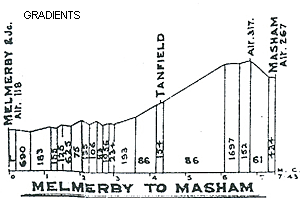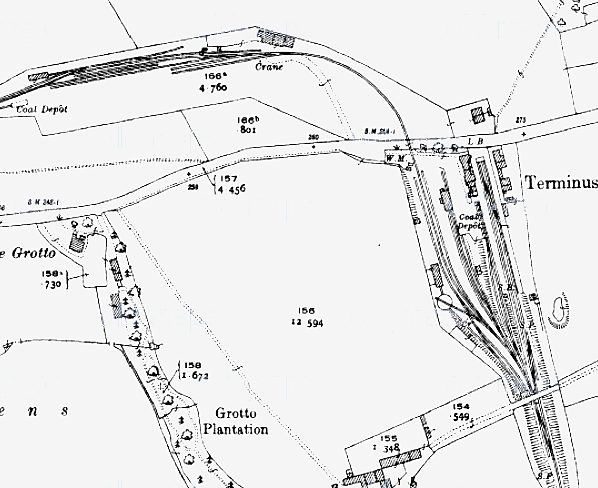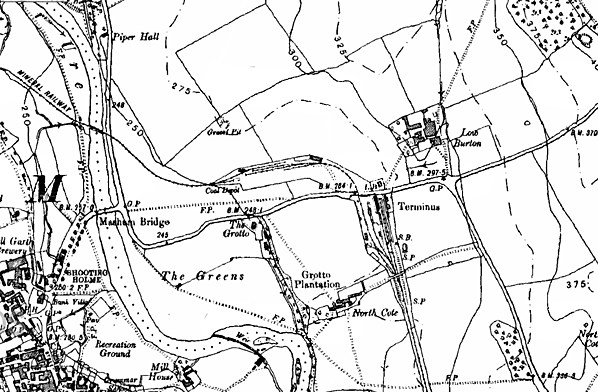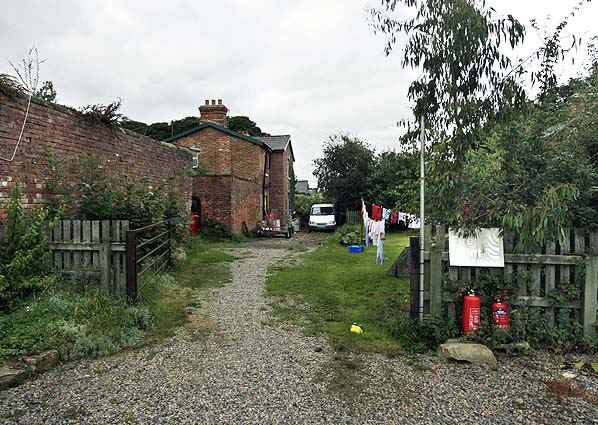Notes: The station building is a substantial brick structure on the down platform comprising a two storey stationmaster's house and a single storey T-shaped building with booking office, station offices and waiting rooms. The gents' toilet was in a separate single storey block at the other end of the house. There was a waiting shelter on the up platform. At its height the railway employed 12 people, the stationmaster (the first stationmaster was Joshua Tennant), two clerks, two goods clerks, three porters and four platelayers.
The station had a substantial goods yard which included five sidings, two of them serving a brick goods shed and a loading dock. A further siding was raised on an embankment to serve coal drops sited behind a high brick wall at the rear of the down platform. A signal box controlling access to the yard was sited on the down platform at the end of the coal drops. There was also a 2-ton crane in the yard.
Masham is a historic market town and boasts one of the largest and finest market squares in England, which was famous for sheep sales in bygone days sometimes with as many as 70,000 sheep being sold every year. Many of the sheep would have been transported by train.
In 1905 one of the sidings was extended across the Masham - Melmerby road to a transhipment yard built in the field on the opposite side of the road. This was the terminus of a 2-foot gauge contractor's tramway serving two reservoir construction sites. The yard had its own coal depot, narrow gauge/standard gauge transhipment dock and a crane.
In October 1908 a McDonnell locomotive hauling a goods train ran out of control, through the goods yard, across the road, eventually ploughing into the soft earth at the end of the standard gauge sidings. Nobody was hurt but the driver, who was unfamiliar with the line and had taken the train to Masham without a conductor, was given a reprimand.
On the west side of the yard, a further siding led to a single-road timber engine shed, large enough to accommodate the two tank engines that worked the line. The shed opened with the line on 9th June 1875 (designated 1R) and could only be accessed across a turntable. The shed was closed by LNER on 1st January 1931 when the passenger service was withdrawn, and demolished in 1941.
| After final closure the station yard was used for grain storage until c.1983 and a number of 200-ton grain silos were built in the yard. In 2005 the site was brought back to life as as a 50-pitch touring caravan site run by the Grainger family who had lived at the station for 37 years. As part of the redevelopment of the site there was a proposal to convert the coal drops |
 |
into holiday cottages (this hasn't happened) and in 2008 the restored goods shed was opened with a picture gallery on the ground floor and the Goods Shed cafe above. In 2008 the station yard was short-listed for the restoration prize in the Yorkshire Rural Awards; but the award went to Richmond station. The site is known as the Old Station Yard Caravan & Camping Park.
BRIEF HISTORY OF THE MASHAM BRANCH
The first scheme for a station near the small market town of Masham in Wensleydale, North Yorkshire, was proposed by the Northern Counties Union Railway, an amalgamation of other local projects and promoters, for a 127 mile line from the Leeds & Thirsk Railway at Melmerby to Leyburn, Hawes, Kirkby Stephen and Appleby and on to a junction with the Lancaster & Carlisle Railway south of Clifton. At Kirkby Stephen, there would be a junction with the Stainmore line running between Bishop Auckland and Tebay. Although the company received its Act on 27th July 1846, the scheme was doomed to failure owing to unworkable clauses being inserted into the Bill at the instigation of the London & North Western Railway and Lancaster & Carlisle Railway who did not want the line to be built, and also opposition from the Duke of Cleveland who was reluctant to sell the company a vital strip of land.
Despite this opposition, a total of 2 ¼ miles was completed, including a section of earthworks north of Melmerby which was sold to the Leeds & Thirsk Railway for their extension to Stockton.
There were no further schemes for a railway to Masham until 1865 when the East & West Yorkshire Union Railway proposed another cross-country route running from the LNWR at Sedbergh to the North Eastern Railway at Melmerby, passing through Garsdale, Leyburn, Middleham and Masham. This scheme was opposed by both the NER and the Midland Railway who were planning to build their own line to Hawes.
Eventually agreement was reached, and the Hawes & Melmerby Railway was incorporated in 1865 with 50% of the capital being provided by the NER. Once again, parliamentary approval was given but, like its predecessor, this scheme also failed when allegations of financial irregularities were made against the NER board in 1867. Although these allegations were proved to be groundless, the board decided that economies should be made. A number of schemes were postponed, including the Hawes & Melmerby, where work was due to start in 1868. When the Midland also expressed doubts about its involvement with the line the whole scheme was in jeopardy, as the time limit imposed by parliament for starting work was due to expire in 1869.
By now the promoters were worried that the line would never be financially viable as it was running through sparsely populated countryside between Leyburn and Melmerby with little hope of attracting much traffic. The NER decided to abandon the line in favour of a branch line to Leyburn and Hawes from Northallerton. The Hawes and Melmerby board agreed to this on condition that the NER built a 7½ mile branch from Melmerby to Masham at their own expense. This was agreed, and the Hawes & Melmerby Company was wound up.
The branch was authorised by the NER Act of 1871 and a contract for the construction was awarded to Scott & Edwards who had submitted the lowest tender in October 1872; work started the following year.
The single track branch line officially opened on 9th June 1875 and the first passenger trains ran the following day. There was one intermediate station at Tanfield. An engine shed for two locomotives with watering and coaling facilities was provided in the goods yard at Masham.
The line never attracted much passenger or freight traffic although Masham station was convenient for visitors to Jervaulx Abbey, Swinton Park and the beautiful woods and walks of Hackfall. In 1901 the NER estimated that Masham served a local population of 3,642, while Tanfield’s catchment was 1,274. In 1911 these stations issued 15,141 and 7,494 tickets respectively. The 1898 NER working timetable shows four passenger trains a day between Ripon and Masham with a daily train for livestock in the morning and a mixed goods train in the afternoon.
Additional freight traffic was generated in the early 20th century when a 6-mile long 2ft gauge contractors' railway was built from Masham to serve Roundhill reservoir which was being built by Harrogate Corporation to the west of the town. This line was also used by Leeds Corporation who had their own scheme to build Leighton reservoir below Roundhill dam, and they agreed to buy the line once the Roundhill reservoir was complete. In April 1905 the two Corporations came to an agreement with the NER to provide transhipment sidings on the north side of the Masham to Melmerby road, opposite the station (which is on the south side). This required a siding in the goods yard to be extended across the road into the new transhipment area. The contractors’ railway ran through the villages of Fearby and Healey to Leighton Bridge and on to the construction sites.
 |
The Leeds reservoir construction started in 1908, and, once the Roundhill reservoir had been completed in 1910, the narrow |
gauge line was purchased by Leeds Corporation. Shortly after the outbreak of WW1, the construction camp was commandeered for military use and was subsequently extended. Work on the reservoir stopped in 1915. The camp was used to house German prisoners of war, bringing additional traffic to both the narrow gauge line and the Masham branch.
Work on Leighton reservoir resumed in 1919, and the narrow gauge line remained in situ until the early 1930s, some years after completion of the reservoir.
There was one major accident on the Masham branch on Easter Monday 5th April 1926 when a down train was derailed on a long curve a mile to the west of Tanfield. There were some 30 passengers in three coaches, but fortunately no one suffered injury or even shock. The derailment was blamed on buckling of the track due to heat, as tight fishplates did not allow the rails to expand.
 |
The Masham branch was absorbed into the London & North Eastern Railway in the 1923 grouping. During the 1920s, passenger traffic remained light. In 1920 there were three trains a day in each direction between Ripon and Masham on weekdays, one in the morning and two in the evening and no Sunday service. By 1922 a short working from Melmerby to Masham had been added at midday, returning to Ripon. It came as no surprise when the passenger service was withdrawn from 1st |
January 1931, although the branch remained open for goods traffic.
WW2 brought a new lease of life to the branch which was used to transport munitions stored locally. This all came by rail rising from 4,000 tons in 1940 to 76,000 tons in 1944. During the build up to D-Day 42 trains were dispatched from Tanfield, each with up to 50 wagons.
After the war, freight traffic returned to normal, consisting mainly of household coal and animal fodder on down trains with malt and agricultural produce being carried in the opposite direction. The line survived into BR days, but this came to an abrupt end when a question about the continued operation of the line was asked in Parliament by Darlington MP Darlington MP Anthony Bourne-Arton. The answer given was that the main purpose of the line was to carry cans of water to certain cottages and to transport coal for the stationmaster at Masham to sell, which was a longstanding NER practice.
The line closed completely on 11th November 1963, although nobody informed the Coal Board, and wagons of coal bound for Masham continued to arrive at Ripon for several days. Two further trips were made along the branch to deliver these and return the empties, so the actual final closure date was a week after the official date.
Ticket from Michael Stewart, NER timetable, Reids Railway Guide and gradients from Alan Young
Sources:
- The Masham Branch by SL Rankin in North Eastern Express: No.36 (North Eastern Railway Association August 1969)
- A history of North Eastern Railway architecture: Volume 2 (North Eastern Railway Association March 2003)
- Railway stations of the North East by K Hoole (David & Charles 1985)
- Darlington & Stockton Times (various dates)
- Yorkshire Post (various dates)
To see other stations on the Masham branch click on the station name: Masham, Tanfield, Melmerby & Ripon |

old10.jpg)



old7.jpg)
old4.jpg)
old1.jpg)
2.jpg)
6.jpg)
12.jpg)
9.jpg)








 Home Page
Home Page